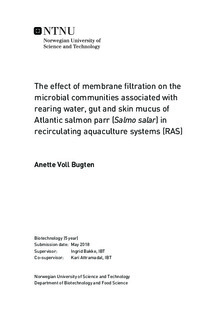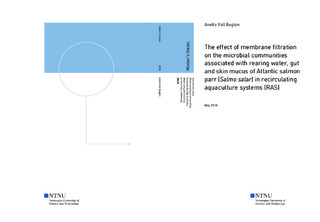| dc.description.abstract | Fish are constantly in contact with microorganisms in the surrounding environment, and their mucosal surfaces; skin, gills and the gastrointestinal tract are colonized by microbiota that play vital functions for their health and welfare. Suboptimal rearing conditions may affect the stability and quality of the microbial communities associated with the rearing water and the fish host, allowing potentially harmful bacteria to proliferate.
Small accumulating organic particles are a problem in recirculating aquaculture systems (RAS) and affects both the water quality and the health of reared Atlantic salmon parr. The objective of this thesis was to investigate the effect of membrane filtration on the microbial communities of the rearing water, gut and skin mucus of Atlantic salmon parr. Water and fish microbiota from two RASs, one conventional RAS (cRAS) and one RAS with a membrane filtration step implemented (mRAS), was examined at two different sampling times representing different feed loadings and water exchange rates. The period prior to the first sampling time (t1) was characterized by high water exchange rate and normal feed loading, while moderate water exchange rate and intentional overfeeding characterized the period prior to the second sampling time (t2). The water, gut and skin mucus microbiota were characterized by Illumina sequencing of the V4-region of the bacterial 16S rRNA gene.
The salmon parr reared in mRAS grew larger compared to the fish in cRAS. The water microbiota was significantly different between cRAS and mRAS, with a more diverse microbial community in mRAS. Three OTUs representing Mycobacterium, Spartobacteria_genera_incertae_sedis and Legionella dominated the water microbiota in cRAS. The first two OTUs increased in abundance at t2. In mRAS, the water communities were dominated by a Sphaerotilus-OTU at t1 and a Flavobacterium-OTU at t2. Fish reared in mRAS had a significantly different gut microbiota and were more similar between the two sampling times compared to that of fish in cRAS. Carnobacterium was the dominant OTU in the gut microbiota of mRAS fish. A Brochothrix-OTU increased highly in abundance at t2, causing the largest difference between the two sampling times in mRAS. The OTUs Mycobacterium, Spartobacteria_genera_incertae_sedis and Legionella were more abundant also in the gut of cRAS fish compared to that of mRAS fish. The two former OTUs increased in abundance at t2, just as in the water microbiota. The skin microbial communities were significantly different at the two sampling times. Both Mycobacterium and Spartobacteria_genera_incertae_sedis became more abundant after the feed overloading period (t2) in both systems, with a higher abundance in the skin microbiota of cRAS. The three presumed opportunists associated with the water also colonized the gut and skin mucus of the fish reared in cRAS. This strongly indicates that the water microbiota affected both the gut and skin mucus microbiota of Atlantic salmon parr. | |

